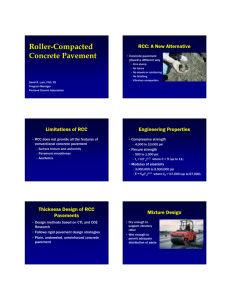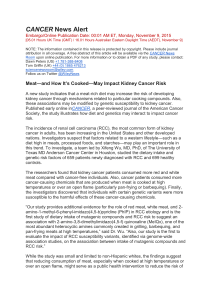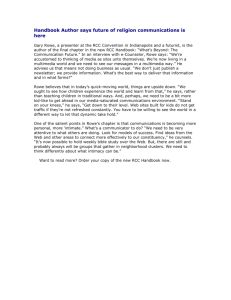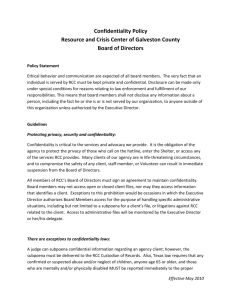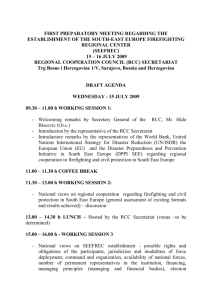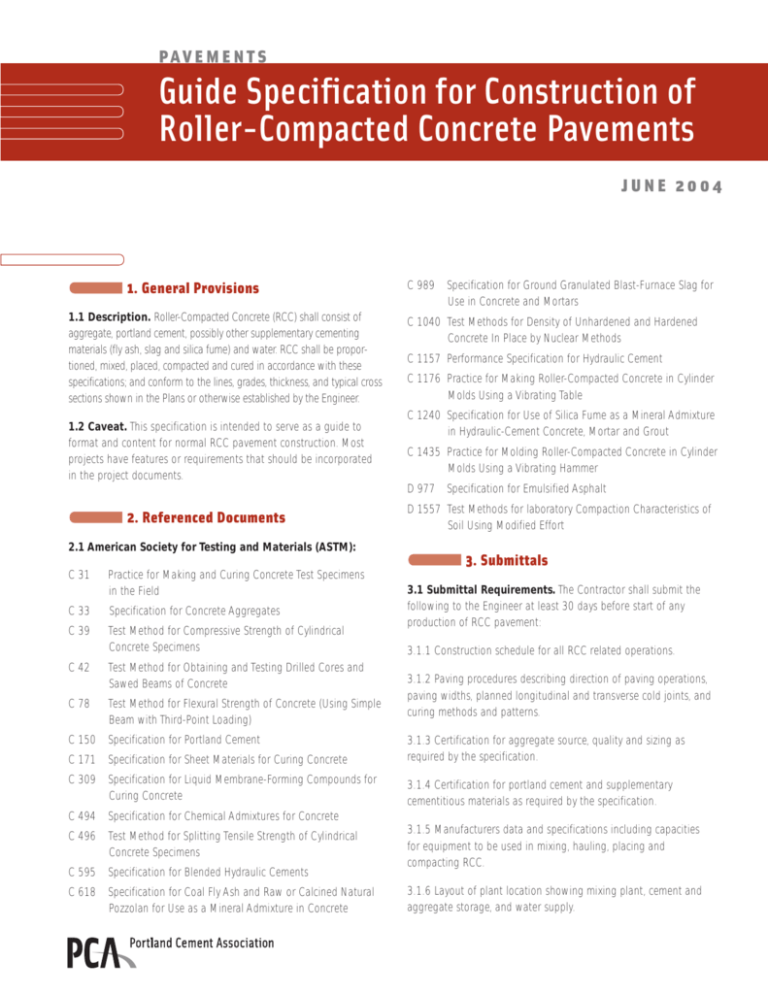
PAVEMENTS
Guide Specification for Construction of
Roller-Compacted Concrete Pavements
JUNE 2004
1. General Provisions
1.1 Description. Roller-Compacted Concrete (RCC) shall consist of
aggregate, portland cement, possibly other supplementary cementing
materials (fly ash, slag and silica fume) and water. RCC shall be proportioned, mixed, placed, compacted and cured in accordance with these
specifications; and conform to the lines, grades, thickness, and typical cross
sections shown in the Plans or otherwise established by the Engineer.
1.2 Caveat. This specification is intended to serve as a guide to
format and content for normal RCC pavement construction. Most
projects have features or requirements that should be incorporated
in the project documents.
C 989
C 1040 Test Methods for Density of Unhardened and Hardened
Concrete In Place by Nuclear Methods
C 1157 Performance Specification for Hydraulic Cement
C 1176 Practice for Making Roller-Compacted Concrete in Cylinder
Molds Using a Vibrating Table
C 1240 Specification for Use of Silica Fume as a Mineral Admixture
in Hydraulic-Cement Concrete, Mortar and Grout
C 1435 Practice for Molding Roller-Compacted Concrete in Cylinder
Molds Using a Vibrating Hammer
D 977
2. Referenced Documents
2.1 American Society for Testing and Materials (ASTM):
C 31
Practice for Making and Curing Concrete Test Specimens
in the Field
C 33
Specification for Concrete Aggregates
C 39
Test Method for Compressive Strength of Cylindrical
Concrete Specimens
C 42
Test Method for Obtaining and Testing Drilled Cores and
Sawed Beams of Concrete
Specification for Ground Granulated Blast-Furnace Slag for
Use in Concrete and Mortars
Specification for Emulsified Asphalt
D 1557 Test Methods for laboratory Compaction Characteristics of
Soil Using Modified Effort
3. Submittals
3.1 Submittal Requirements. The Contractor shall submit the
following to the Engineer at least 30 days before start of any
production of RCC pavement:
3.1.1 Construction schedule for all RCC related operations.
3.1.2 Paving procedures describing direction of paving operations,
paving widths, planned longitudinal and transverse cold joints, and
curing methods and patterns.
C 78
Test Method for Flexural Strength of Concrete (Using Simple
Beam with Third-Point Loading)
C 150
Specification for Portland Cement
C 171
Specification for Sheet Materials for Curing Concrete
3.1.3 Certification for aggregate source, quality and sizing as
required by the specification.
C 309
Specification for Liquid Membrane-Forming Compounds for
Curing Concrete
3.1.4 Certification for portland cement and supplementary
cementitious materials as required by the specification.
C 494
Specification for Chemical Admixtures for Concrete
C 496
Test Method for Splitting Tensile Strength of Cylindrical
Concrete Specimens
C 595
Specification for Blended Hydraulic Cements
C 618
Specification for Coal Fly Ash and Raw or Calcined Natural
Pozzolan for Use as a Mineral Admixture in Concrete
3.1.5 Manufacturers data and specifications including capacities
for equipment to be used in mixing, hauling, placing and
compacting RCC.
3.1.6 Layout of plant location showing mixing plant, cement and
aggregate storage, and water supply.
3.1.7 Proposed RCC Mix Design. If the proposed mix design is developed by the Contractor or there is a suggested change to the mix
design, it must be submitted to the Engineer for approval at least
four weeks prior to RCC construction. This mix design shall include
details on aggregate gradation, cementitious materials, admixtures (if
used), compressive and/or flexural strengths, and required moisture
and density to be achieved.
4.7 Curing Compound. Concrete curing compounds shall conform
to ASTM C 309 or ASTM D 977.
5. Equipment
5.1 General. All necessary equipment shall be on hand and
approved by the Engineer before work will be permitted. Roller-compacted concrete shall be constructed with any combination of equipment that will produce a completed pavement meeting the
requirements for mixing, transporting, placing, compacting, finishing,
and curing as provided in this specification.
4. Materials
4.1 General. All materials to be used for RCC pavement construction shall be approved by the Engineer based on laboratory tests or
certifications of representative materials which will be used in the
actual construction.
5.2 Mixing Plant.
5.2.1 Location of Plant. The mixing plant shall be located within a 30
minute haul time from the RCC placement. With prior testing and
Engineer’s approval, a set retarding admixture may be used to extend
the haul time.
4.2 Portland Cement. Cement shall comply with the latest specifications for portland cement (ASTM C 150 and ASTM C 1157), or
blended hydraulic cements (ASTM C 595 and ASTM C 1157)
5.2.2 Plant Capacity. The plant shall be capable of producing an RCC
mixture in the proportions defined by the final approved mix design
and within the specified tolerances. The capacity of the plant shall be
sufficient to produce a uniform mixture at a rate compatible with the
placement equipment. The volume of RCC material in the mixing
chamber shall not be more than the rated capacity for dry concrete
mixtures.1 Multiple plants shall be supplied if a single plant can not
provide an uninterrupted supply of RCC to the paver(s) during peak
paving operations.
4.3 Aggregates. Unless otherwise approved in writing by the
Engineer, the quality of aggregates shall conform to ASTM C 33. The
plasticity index of the aggregate shall not exceed five. Aggregates may
be obtained from a single source or borrow pit, or may be a blend of
coarse and fine aggregate. The aggregate shall be well-graded
without gradation gaps and conform to the following gradation:
Sieve Size
Percent passing by weight
1" (25 mm)
100
3/4" (19 mm)
90-100
1/2" (12.5 mm)
70-90
3/8" (9.5 mm)
60-85
No. 4 (4.75 mm)
40-60
No. 16 (1.18 mm)
20-40
No. 100 (150 µm)
6-18
No. 200 (75 µm)
2-8
5.2.3 Pugmill Plant. A pugmill plant shall be a central plant with a
twin shaft pugmill mixer, capable of batch or continuous mixing,
equipped with synchronized metering devices and feeders to maintain the correct proportions of aggregate, cement, mineral admixture
and water. Other pugmill plant requirements are as follows:
5.2.3.1 Aggregate Storage. If previously blended aggregate is furnished, storage may be in a stockpile from which it is fed directly
to a conveyor feeding the mixer. If aggregate is furnished in two
or more size groups, aggregate separation must be provided at
the stockpiles.
4.4 Mineral Admixtures. Mineral admixtures shall conform to
the requirements of ASTM C 618 (flyash), ASTM C 989 (slag) and
ASTM C 1240 (silica fume). Unless specifically directed by the
Engineer, total mineral admixture content including the content in
blended cements shall not exceed the weight of portland cement in
the RCC mix.
5.2.3.2 Aggregate bins shall have a feed rate controlled by a variable
speed belt, or an operable gate calibrated to accurately deliver any
specified quantity of material. If two or more aggregate size stockpile
sources are used, the feed rate from each bin shall be readily
adjustable to change aggregate proportions, when required. Feed
rate controls must maintain the established proportions of aggregate
from each stockpile bin when the combined aggregate delivery is
increased or decreased.
4.5 Chemical Admixtures. Chemical admixtures including waterreducing and retarding admixtures shall conform to ASTM C 494 and
must be approved by the Engineer prior to use.
4.6 Water. Water shall be clean, clear and free of acids, salts, alkalis
or organic materials that may be injurious to the quality of the
concrete. Non-potable water may be considered as a source for part
or all of the water, providing the mix design indicates proof that the
use of such water will not have any deleterious effect on the strength
and durability properties of the RCC.
5.2.3.3 Plant Scales. Plant scales for any weigh box or hopper shall
be either of beam or springless-dial type, and be sensitive to 0.5 per1. Because of the very dry consistency of RCC, the batch volume of mixed
material especially for drum mixers may need to be less than the manufacture’s rated capacity of the mixer for conventional concrete.
2
Guide Specification for Construction of RCC Pavements
cent of the maximum load required. Beam-type scales shall have a
separate beam for each aggregate size, with a single telltale actuated for each beam, and a tare beam for balancing hopper. Belt scales
shall be of an approved design. Standard test weights accurate to
plus or minus 0.1 percent shall be provided for checking plant scales.
measuring the water to within a tolerance of plus or minus one percent and shall be equipped with an accurate gauge or dial measuring
device. During batching, water shall be admitted to the mixer only
through the water measuring device and then only at time of charging.
5.2.4.4 Drum mixers shall be equipped with an accurate clock or
timing device, capable of being locked, for visibly indicating the time
of mixing after all the materials, including the water, are in the mixer.
5.2.3.4 Cement and Mineral Admixture Material Storage. Separate and
independent storage silos shall be used for portland cement and mineral admixture. Each silo must be clearly identified to avoid confusion
during silo loadings. If the Contractor chooses to preblend the cementitious material he must employ blending equipment acceptable to the
Engineer and demonstrate, with a testing plan, the ability to successfully produce a uniform blended material meeting the mix design
requirements. Testing of the preblended cementitious material shall be
done on a daily basis to assure both uniformity and proper quantities.
5.2.5 Alternative Mixing Equipment. Other types of batching and
mixing equipment and configurations including dry batch plants and
concrete truck mixers may be used with the approval of the Engineer.
The Contractor must demonstrate that the mixing equipment has the
ability to produce a consistent, well-blended, non-segregated RCC
mix satisfying the minimum capacity requirements of Section 5.2.2
and within the tolerance limits as specified in Section 6.3.2.
5.2.3.5 Cement and Mineral Admixture Feed Unit. Satisfactory means
of dispensing portland cement and mineral admixture, volumetrically
or by weight, shall be provided to assure a uniform and accurate
quantity of cementitious material enters the mixer.
5.3 Paver.
5.3.1 RCC shall be placed with a high-density or conventional
asphalt type paver subject to approval by the Engineer. The paver
shall be capable of placing RCC to a minimum of 85% of the maximum wet density in accordance with ASTM D 1557 or equivalent test
method. The paver shall be of suitable weight and stability to spread
and finish the RCC material, without segregation, to the required
thickness, smoothness, surface texture, cross-section and grade.
5.2.3.6 Water Control Unit. Required amount of water for the
approved mix shall be measured by weight or volume. The unit shall
be equipped with an accurate metering device. The water flow shall
be controlled by a meter, valve or other approved regulating device
to maintain uniform moisture content in the mixture.
5.2.3.7 Surge Hopper. For continuous operating pugmills, a surge
hopper attached to the end of the final discharge belt shall be
provided to temporarily hold the RCC discharge to allow the plant
to operate continuously.
5.3.2 Alternative Paving Equipment. Any alternative paving equipment such as graders and dozers must be approved by the Engineer
prior to use. The equipment shall be capable of producing a finished
product that results in a smooth, continuous surface without segregation, excessive tearing, or rock pockets.
5.2.4 Rotary Central-Mix Drum Plant. A rotary drum batch mixer shall
be capable of producing a homogeneous mixture, uniform in color
and having all coarse aggregate coated with cementitious paste.
The mixer shall be equipped with batching equipment to meet the
following requirements:
5.4 Compactors.
5.4.1 Self-propelled steel drum vibratory rollers having a minimum
static weight of 10 tons (9.07 metric tons) shall be used for primary
compaction. For final compaction either a steel drum roller, operated
in a static mode, or a pneumatic-tire roller shall be utilized.
5.2.4.1 The amounts of cement, mineral admixture and aggregate
entering into each batch of RCC shall be measured by direct weighing equipment. Weighing equipment shall be readily adjustable to
compensate for the moisture content of the aggregate or for changing the proportionate batch weights, and shall include a visible dial
or equally suitable device which will accurately register the scale load
from zero to full capacity. The cement and mineral admixture may be
weighed separately or cumulatively in the same hopper on the same
scale, provided the cement is weighed first.
5.4.2 Walk-behind vibratory rollers or plate tampers shall be used for
compacting areas inaccessible to the large rollers.
5.5 Haul Trucks. Trucks for hauling the RCC material from the plant
to the paver shall have covers available to protect the material from rain
or excessive evaporation. The number of trucks shall be sufficient to
ensure adequate and continuous supply of RCC material to the paver.
5.6 Water Trucks. At least one water truck, or other similar
equipment, shall be on-site and available for use throughout the
paving and curing process. Such equipment shall be capable of
evenly applying a fine spray of water to the surface of the RCC
without damaging the final surface.
5.2.4.2 Bulk cement and mineral admixture weigh hoppers shall be
equipped with vibrators to operate automatically and continuously
while weighing hoppers are being dumped. The weigh hopper shall
have sufficient capacity to hold not less than 10 percent in excess of
the cementitious material required for one batch.
5.7 Inspection of Equipment. Before start-up, the Contractor‘s
equipment shall be carefully inspected. Should any of the equipment
fail to operate properly, no work shall proceed until the deficiencies
are corrected.
5.2.4.3 The amount of water entering each batch of RCC shall be
measured by weight or volume. The equipment shall be capable of
3
5.8 Access for Inspection and Calibration. The Engineer shall
have access at all times to any plant, equipment or machinery to be
used on this project in order to check calibration, scales, controls or
operating adjustments.
6.2.4.2 Cores and Beams. The test section shall be cured at least 5
days prior to extracting cores and beams for testing. The cores and
beams shall be obtained in accordance with ASTM C 42. The cores
will be tested for splitting tensile strength (ASTM C 496) and compressive strength (ASTM C 39) at 7, 14 and 28 days of age. In addition, 6x6x21 in. (150x150x525 mm) beams will be sawn from the
test section and flexural strength at 7, 14 and 28 days will be determined in accordance with ASTM C 78. All coring, cutting and testing
of the test section shall be paid for by the Owner.
6. Construction Requirements
6.1 Preparation of Subgrade/Subbase.2 Before RCC processing
begins, the area to be paved shall be graded and shaped to the lines
and grades as shown in the Plans or as directed by the Engineer.
During this process any unsuitable soil or material shall be removed
and replaced with acceptable material. The subgrade shall be uniformly compacted to a minimum of 95% of the maximum dry density
in accordance with ASTM D 1557. The Contractor shall check for
any soft or yielding subgrade areas by proof rolling with a loaded
dump truck or pneumatic-tire roller over the entire area to be paved.
All soft or yielding subgrade areas shall be corrected and made
stable before RCC construction begins. If a subbase is shown on
the Plans, it shall be uniformly compacted to a minimum of 95% of
the maximum dry density in accordance with ASTM D 1557.
6.3 Mixing Process.
6.3.1 General. Except for minor variations in moisture content, the
same mixture proportions shall be used for the entire project, unless
otherwise stated in the project documents. The water content shall
be varied by the Contractor, as necessary, to provide a consistency
that is most conducive to effective placement and compaction. If
during mixing there is a change in the type or source of cementitious
materials, or aggregates, the mixing must be suspended, and a new
mix design shall be developed.
6.3.2 Mixture Ingredient Tolerances. The mixing plant must receive the
quantities of individual ingredients to within the following tolerances:
6.2 Test Section (Optional).
6.2.1 At least 30 days before the start of paving operations, the
Contractor shall construct a test section using the trial mix design.
This test pavement will allow the Engineer to evaluate the strength of
the RCC material, methods of construction, curing process and surface
conditions of the completed test pavement. The test section shall be
at least 50 feet (15 meters) long and a minimum of two paver widths
wide. It shall be located in a non-critical area or as indicated on the
Plans. The test pavement will be constructed over an extended period
to demonstrate the construction of cold joints in both a longitudinal
and transverse direction, as well as fresh joint construction.
Material
Variation in % by Weight
Cementitious materials
+/- 2.0
Water
+/- 3.0
Aggregates
+/- 4.0
6.3.3 Mixing time will be that which will assure complete and
uniform mixing of all ingredients. For drum mixers and dry batch
facilities, the time of mixing shall be determined from uniformity
test results.
6.2.2 The equipment, materials and techniques used to construct the
test section shall be that which will be used to construct the main
RCC pavement.
6.3.4 All material must be discharged before recharging. The mixing
chamber and mixer blade surfaces must be kept free of hardened
RCC or other buildups. Mixer blades shall be checked routinely for
wear and replaced if wear is sufficient to cause inadequate mixing.
6.2.3 During construction of the test section the Contractor will
establish an optimum rolling pattern and procedure for obtaining
a density of not less than 98% of the maximum wet density in
accordance with ASTM D 1557 or equivalent test method. In addition, the Contractor must also demonstrate the ability to achieve a
smooth, hard, uniform surface free of excessive tears, ridges, spalls
and loose material.
6.3.5 Plant Calibration. Prior to commencement of RCC production,
the Contractor shall carry out a complete and comprehensive calibration of the plant in accordance with the manufacturer's recommended practice. All scales, containers and other items necessary to
complete the calibration shall be provided by the Contractor. After
completion of the initial calibration, the plant shall be recalibrated as
directed by the Engineer.
6.2.4 Strength Testing (Optional Tests).
6.2.4.1 Field Cast Specimens. Specimens shall be prepared in accordance with ASTM D 1557, ASTM C 1435, or ASTM C 1176. Cure and
transport specimens to the laboratory in accordance with ASTM C 31.
Specimens shall be tested for splitting tensile strength (ASTM C 496)
and compressive strength (ASTM C 39) at 7, 14, and 28 days of age.
6.3.6 Daily Reports. The Contractor shall supply daily plant records of
production and quantities of materials used that day to the Engineer.
6.4 Transportation. The transportation of the RCC pavement material from the plant to the areas to be paved shall be in dump trucks
fitted and equipped, when necessary, with retractable protective covers for protection from rain or excessive evaporation. The trucks shall
be dumped clean with no buildup or hanging of RCC material. For
paver placed RCC, the dump trucks shall deposit the RCC material
2. Preparation of the subgrade/subbase is frequently the responsibility of
excavation/grading contractor.
4
Guide Specification for Construction of RCC Pavements
Contractor shall submit his method of placement and lift thickness as
part of a paving plan subject to approval by the Engineer. In multiple
lift construction, the second lift must be placed within 60 minutes of
the completion of the first lift. If more than 60 minutes has elapsed,
the interface between the first and second lifts shall be considered a
cold joint and shall be prepared in accordance with Section 6.8.3.1.
At the discretion of the Engineer, this time may be increased or
decreased depending on the use of set retarding admixtures or the
ambient weather conditions of temperature, wind and humidity.
directly into the hopper of the paver or into a secondary material distribution system which deposits the material into the paver hopper.
Dump truck delivery must be scheduled so that RCC material is
spread and compacted within the specified time limits.
6.5 Placing.
6.5.1 Condition of the Subgrade/Subbase. Prior to RCC placement, the
surface of the subgrade/subbase shall be clean and free of foreign
material, ponded water and frost prior to the placement of the RCC
pavement mixture. The subgrade/subbase must be uniformly moist at
the time of RCC placement. If sprinkling of water is required to
remoisten certain areas, the method of sprinkling shall not be such
that it forms mud or pools of free-standing water. Prior to placement
of RCC, the subgrade/subbase shall be checked for proper density and
soft or yielding areas and these areas shall be corrected as specified
in Section 6.1.
6.5.6 Hand Spreading. Broadcasting or fanning the RCC material
across areas being compacted will not be permitted. Such additions
of material may only be done immediately behind the paver and
before any compaction has taken place. Any segregated coarse
aggregate shall be removed from the surface before rolling.
6.5.7 Segregation. If segregation occurs in the RCC during paving
operations the spreading shall cease until the cause is determined
and corrected.
6.5.2 Paver Requirements. RCC shall be placed with an approved
paver as specified in Section 5.3 and shall meet the following
requirements:
6.5.8 RCC placement shall be done in a pattern so that the curing
water from the previous placements will not pose a runoff problem
on the fresh RCC surface or on the subbase layer.
6.5.2.1 The quantity of RCC material in the paver shall not be
allowed to approach empty between loads. The material shall be
maintained above the auger shaft at all times during paving.
6.5.9 Paving Inaccessible Areas. Areas inaccessible to either paver or
roller may be placed by hand and compacted with equipment specified in Section 5.4.2. Compaction of these areas must satisfy minimum density requirements as specified in Section 6.7.7. An alternate
and preferred method for paving inaccessible areas is to use cast-inplace, air-entrained concrete with a minimum compressive strength
of 4000 psi (27 MPa) or as specified by the Engineer. In areas that
may be subjected to high load transfer, the Engineer may require the
cast-in-place concrete to be doweled into the RCC.
6.5.2.2 The paver shall operate in a manner that will prevent segregation and produce a smooth continuous surface without tearing,
pulling or shoving. The spread of the RCC shall be limited to a length
that can be compacted and finished within the appropriate time limit
under the prevailing air temperature, wind, and climatic conditions.
6.5.2.3 The paver shall proceed in a steady, continuous operation
with minimal starts and stops. Paver speed during placement operations shall not exceed the speed necessary to ensure that minimum
density requirements as specified in Section 5.3.1 are met and surface distress is minimized.
6.5.10 Placement of RCC with graders, dozers or other alternative
paving equipment as specified in Section 5.3.2 shall meet the
requirements of paver placed RCC where applicable.
6.5.2.4 The surface of the RCC pavement once it leaves the paver
shall be smooth, uniform and continuous without excessive tears,
ridges or aggregate segregation.
6.6 Weather Conditions.
6.6.1 Cold Weather Precautions. RCC material shall not be placed on
any surface containing frost or frozen material or when the air temperature is below 40°F (4°C), except when the air temperature is at
least 35°F (2°C) and rising. When the air temperature is expected to
fall below 40°F (4°C), the Contractor must present to the Engineer a
detailed proposal for protecting the RCC pavement. This proposal
must be accepted by the Engineer before paving operations may be
resumed. A sufficient supply of protective material such as insulating
blankets, plastic sheeting, straw, burlap or other suitable material
shall be provided by the Contractor at his expense. The methods and
materials used shall be such that a minimum temperature of 40°F
(4°C) at the pavement surface will be maintained for a minimum of
five days. Approval of the Contractor‘s proposal for frost protection
shall not relieve the Contractor of the responsibility for the quality
and strength of the RCC placed during cold weather. Any RCC that
freezes shall be removed and replaced at the Contractors expense.
6.5.3 Lift Thickness. Lift thickness of compacted RCC pavement shall
be as indicated on the Plans. If RCC pavements are to be constructed
in a thickness greater than 10 inches (250 mm), the use of two lifts
shall be utilized. No lift shall be less than 4 inches (100 mm).
6.5.4 Adjacent Lane Placement. Adjacent paving lanes shall be
placed within 60 minutes. If more than 60 minutes elapses between
placement of adjacent lanes, the vertical joint must be considered a
cold joint and shall be prepared in accordance with Section 6.8.2.
At the Engineer's discretion, this time may be increased or decreased
depending on the use of set retarding admixtures or the ambient
weather conditions of temperature, wind, and humidity.
6.5.5 Multiple Lift Placement. For multiple lift placement, the total
pavement thickness shall be as shown on the Plans, and the
5
6.7.7 Density Requirements. In-place field density tests shall be
performed in accordance with ASTM C 1040, direct transmission,
as soon as possible, but no later than 30 minutes after completion
of rolling. Only wet density shall be used for evaluation. The required
density shall be not less than 98% of the maximum wet density
obtained by ASTM D 1557 or equivalent test method based on a
moving average of five consecutive tests with no test below 96%.
6.6.2 Hot Weather Precautions. During periods of hot weather or
windy conditions, special precautions shall be taken to minimize
moisture loss due to evaporation. Under conditions of excessive
surface evaporation due to a combination of air temperature, relative
humidity, concrete temperature and wind conditions, the Contractor
must present to the Engineer a detailed proposal for minimizing
moisture loss and protecting the RCC. Precautions may include
cooling of aggregate stockpiles by use of a water spray, protective
covers on dump trucks, temporary wind breaks to reduce wind effect,
cooling of concrete mix water, and decreasing the allowable time
between mixing and final compaction.
6.8 Joints.
6.8.1 Fresh Vertical Joints. A vertical joint shall be considered a
fresh joint when an adjacent RCC lane is placed within 60 minutes
of placing the previous lane, with the time adjusted depending on
use of retarders or ambient conditions. Fresh joints do not require
special treatment.
6.6.3 Rain Limitations. No placement of RCC pavement shall be
done while it is raining hard enough to be detrimental to the finished
product. Placement may continue during light rain or mists provided
the surface of the RCC pavement is not washed-out or damaged due
to tracking or pickup by dump trucks or rollers. Dump truck covers
must be used during these periods. The Engineer will be the sole
judge as to when placement must be stopped due to rain.
6.8.2 Cold Vertical Joints. Any planned or unplanned construction
joints that do not qualify as fresh joints shall be considered cold
joints and shall be treated as follows:
6.8.2.1 Longitudinal and Transverse Cold Joints. Formed joints that
do not meet the minimum density requirements of Section 6.7.7
and all unformed joints shall be cut vertically for the full depth. The
vertical cut shall be at least 6 in (150 mm) from the exposed edge.
Cold joints cut within two hours of placement may be cut with an
approved wheel cutter, motor grader or other approved method provided that no significant edge raveling occurs. Cold joints cut after
two hours of placement shall be saw cut 1/4 to 1/3 depth of the RCC
pavement with the rest removed by hand or mechanical equipment.
Any modification or substitution of the saw cutting procedure must
be demonstrated to and accepted by the Engineer. All excess material
from the joint cutting shall be removed.
6.7 Compaction.
6.7.1 Compaction shall begin immediately behind the placement process and shall be completed within 60 minutes of the start of plant
mixing. The time may be increased or decreased at the discretion of
the Engineer depending on use of set retarding admixtures or ambient weather conditions of temperature, wind and humidity.
6.7.2 Rolling. The Contractor shall determine the sequence and
number of passes by vibratory and non-vibratory rolling to obtain the
minimum specified density and surface finish. Rollers shall only be
operated in the vibratory mode while moving. Pneumatic-tire rollers
may be used during final compaction to knead and seal the surface.
6.8.2.2 Prior to placing fresh RCC mixture against a compacted cold
vertical joint, the joint shall be thoroughly cleaned of any loose or
foreign material. The vertical joint face shall be wetted and in a moist
condition immediately prior to placement of the adjacent lane.
6.7.3 Rolling Longitudinal and Transverse Joints. The roller shall not
operate within 12 in. (300 mm) of the edge of a freshly placed lane
until the adjacent lane is placed. Then both edges of the two lanes
shall be rolled together within the allowable time. If a cold joint is
planned, the complete lane shall be rolled and cold joint procedures,
as specified in Section 6.8.2 shall be followed.
6.8.3 Fresh Horizontal Joints. For multi-layer construction a horizontal
joint shall be considered a fresh joint when a subsequent RCC lift is
placed within 60 minutes of placement of the previous lift. This time
may be adjusted at the discretion of the Engineer depending on use
of retarders or ambient weather conditions. Fresh joints do not
require special treatment other than cleaning the surface of all
loose material and moistening the surface prior to placement of the
subsequent lift.
6.7.4 Longitudinal joints shall be given additional rolling as necessary to produce the specified density for the full depth of the lift
and a tight smooth transition occurs across the joint. Any uneven
marks left during the vibrating rolling shall be smoothed out by
non-vibrating or rubber tire rolling. The surface shall be rolled until
a relatively smooth, flat surface, reasonably free of tearing and
cracking is obtained.
6.7.5 Speed of the rollers shall be slow enough at all times to avoid
displacement of the RCC pavement. Displacement of the surface
resulting from reversing or turning action of the roller shall be
corrected immediately.
6.8.3.1 Horizontal Cold Lift Joints. For horizontal cold joints the surface of the lift shall be kept continuously moist and cleaned of all
loose material prior to placement of the subsequent lift. The Engineer
may require other action such as use of a cement slurry or mortar
grout between lifts. If supplementary bonding materials are used,
they shall be applied immediately prior to placement of the
subsequent lift.
6.7.6 Areas inaccessible to large rollers shall be treated as specified
in Section 6.5.9.
6.8.3.2 RCC Pavement Joints at Structures. The joints between RCC
pavement and concrete structures shall be treated as cold vertical joints.
6
Guide Specification for Construction of RCC Pavements
6.11 Traffic. The Contractor shall protect the RCC from vehicular
traffic during the curing period. Completed portions of the RCC
pavement may be opened to traffic after seven days or as approved
by the Engineer.
6.8.4 Control Joints (Optional). Control joints may be constructed in
the RCC pavement to induce cracking at pre-selected locations. Joint
locations shall be shown on the Plans or as directed by the Engineer.
Early entry saws should be utilized as soon as possible behind the
rolling operation and set to manufacturer’s recommendations.
Conventionally cut control joints shall be saw cut to 1/4 depth of the
compacted RCC pavement. Joints shall be saw cut as soon as those
operations will not result in significant raveling or other damage to
the RCC pavement.
6.12 Maintenance. The Contractor shall maintain the RCC pavement
in good condition until all work is completed and accepted. Such
maintenance shall be performed by the Contractor at his own expense.
7. Measurement and Payment
6.9 Finishing.
6.9.1 Surface Smoothness. The finished surface of the RCC pavement, when tested with a 10 foot (3 meter) straight edge or crown
surface template, shall not vary from the straight edge or template
by more than 3/8 inch (10 mm) at any one point. When the surface
smoothness is outside the specified surface tolerance the Contractor
shall grind the surface to within the tolerance by use of selfpropelled diamond grinders. Milling of the final surface is not
acceptable, unless it is for the removal of the pavement.
7.1 Measurement. The work described in this document will be
measured (1) in square yards (square meters) of completed and
accepted RCC pavement as determined by the specified lines, grades
and cross sections shown on the Plans and (2) in cubic yards (cubic
meters) or tons (metric tons) of mixed and hauled RCC material.
7.2 Payment.
7.2.1 The work described in this document will be paid for at the
contract unit price per square yard (square meter) of completed
and accepted RCC pavement. The price shall include placement,
compaction, curing, inspection and testing assistance and all other
incidental operations. Also payment shall be made at the contract
unit price per cubic yard (cubic meter) or ton (metric tons) of mixed
and hauled RCC material. The price shall include mixing, hauling and
all material costs. Such payment shall constitute full reimbursement
for all work necessary to complete the RCC pavement.
6.9.2 Thickness. The thickness of the RCC pavement shall not deviate
from that shown on the plans or as directed by the Engineer by more
than minus 1/2 inch (12.5 mm). Pavement of insufficient thickness
shall be removed and replaced the full depth. No skin patches shall
be accepted.
6.9.3 When surface irregularities are outside the tolerances cited
above, the contractor shall grind the surface to meet the tolerance
at no additional cost to the Owner.
7.2.2 Test Section. If a test section is constructed, it will be paid for
on a lump sum basis. Such payment shall constitute full reimbursement for all materials, labor, equipment, mobilization, demobilization,
and all other incidentals necessary to construct the Test Section in
accordance with Section 6.2.
6.10 Curing. Immediately after final rolling and compaction testing,
the surface of the RCC pavement shall be kept continuously moist for
7 days or until an approved curing method is applied.
6.10.1 Water Cure. Water cure shall be applied by water trucks
equipped with misting spray nozzles, soaking hoses, sprinkler system
or other means that will assure a uniform moist condition to the
RCC. Application of this moisture must be done in a manner that will
not wash out or damage the surface of the finished RCC pavement.
6.10.2 Curing Compound. The specified membrane curing compound
shall be applied in two separate applications at right angles to one
another, with the first coat being allowed to become tacky before the
second is applied. This application must ensure a uniform void-free
membrane across the entire RCC pavement. If the application rate is
found to be excessive or insufficient, the Contractor, with approval of
the Engineer, can decrease or increase the application rate to a level
which achieves a void-free surface without ponding.
6.10.3 Sheet Materials. Curing paper, plastic and other sheet
materials for curing RCC shall conform to ASTM C 171. The
coverings shall be held securely in place and weighted to maintain
a close contact with the RCC surface throughout the entire curing
period. The edges of adjoining sheets shall be overlapped and held
in place with sand bags, planking, pressure adhesive tape, or other
Engineer-approved method.
7
Portland Cement Association (PCA) is a not-for-profit organization and
provides this publication solely for the continuing education of qualified
professionals. THIS PUBLICATION SHOULD ONLY BE USED BY QUALIFIED
PROFESSIONALS who possess all required license(s), who are competent
to evaluate the significance and limitations of the information provided
herein, and who accept total responsibility for the application of this
information. OTHER READERS SHOULD OBTAIN ASSISTANCE FROM A
QUALIFIED PROFESSIONAL BEFORE PROCEEDING.
PCA and its members make no express or implied warranty in
connection with this publication or any information contained herein.
In particular, no warranty is made of merchantability or fitness for a
particular purpose. PCA and its members disclaim any product liability
(including without limitation any strict liability in tort) in connection
with this publication or any information contained herein.
An organization of cement companies to
improve and extend the uses of portland
cement and concrete through market
development, engineering, research,
education, and public affairs work.
© 2004 Portland Cement Association
All rights reserved
IS009.01

